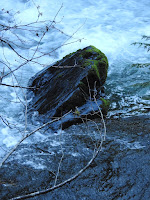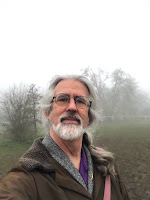The other day I had the opportunity to purchase a copy of C G Jung's "The Red Book (Liber Novus)." When it first came out, I had wanted a copy, but felt like it was out of my budget. I would read summaries of it in news articles and wonder at some of the more striking illustrations of trees and dragons and sailing ships.
I hadn't realized until I was hefting it out of Tsunami Books that it's a massive, oversized tome. Holding it is like being six and opening a large, unabridged dictionary; or like retrieving some sorcerer's tome. I was momentarily transported to my parents' study in in the seventies, which at the time had a eight foot by twelve foot bookshelf filled with books, books, books, books, books -- really big books of Egyptian antiquities, old US History books, dictionaries and encyclopedias and atlases, and old college course books (okay, and reel-to-reel tape recordings of Bach, Mozart, Vivaldi, and Fred Waring & His Pennsylvanians...). Owning the book is comforting and pleasurable, and I'm pretty sure I need to make a little shrine for it.
I've only sat down with "The Red Book" for a few sessions so far. It's such a large book that I've had to improvise an archivist's lectern for it out of small pillows in an attempt to protect the spine.
The first part of the book is page after page of facsimiles of Jung's carefully ruled and executed calligraphy and the luminous paintings of his dreams and self-guided participatory meditations.
When I first learned of "The Red Book," I thought Jung had been having sessions in his attic where he would write and paint the images in it -- but in reality he transcribed a first draft of notes and drawings before laying out the calligraphic text and illustrations.
He wanted his book to be a work of art, a precious book.
The next part of the book is the translator's introduction and brief biography of Jung. This is followed by an English translation of the German in the facsimile.
The best question that Jung asks is from an excerpt of his writings in the translator's introduction: "What is the myth you are living?"
What's struck me so far is that Jung seems to have developed a method of self-guided, participatory meditations similar to what some Tarot card readers suggest to their students: look at or imagine a scene, then insert yourself into the scene and interact with what or who you find there. I can't help but be reminded of how Dion Fortune says she would enter the astral plane by lucid dreaming herself there using symbols (established by the Golden Dawn) as signposts for her progress; or how other occultists suggest imagining traveling up the Tree of Life and conversing with the angelic beings at each station.
In Jung's case, he seems to have developed the Hero's Journey as a symbolic method for circling around different aspects of his Self.
What's also struck me is how binary Jung's system is: primitive/civilized; dark/light; lexical/symbolic; rational/insane; male/female; science/art. I'm guessing this is a product of him being a European man before World War I. I think I can detect traces of Egypt-mania in the work, too.
From what I can gather from the introduction, it sounds like he decided he wanted to be a lexical, logical, rational scientist instead of someone more grounded in the humanities. I'm inferring his artistic talents seemed to come from a symbolic, illogical, irrational space that was confusing (or troubling) to him, so he experimented on himself with the tools of psychoanalysis in an attempt to integrate different parts of himself.
But his focus on the rational and on words and logos does make me wonder what he thought of improvisational music and musicians. I guess I'll have to find out as I read more.


















